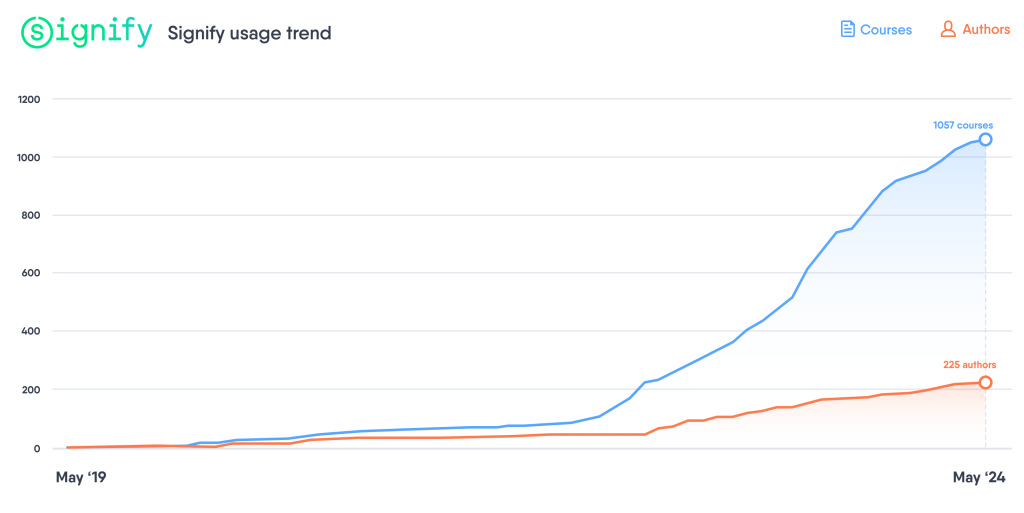Introduction
Signify, formerly known as Philips Lighting, is a global leader in lighting products, systems, and services. The company operates in over 70 countries and has more than 32,000 employees. Joseph Bejjani and Win Yi Wong are part of Signify’s Learning team as Global Learning Program Managers. They are responsible for identifying and closing the skill gaps in Signify’s workforce. Jaap Schuuring is the Head of Customer Learning, and he oversees training for customers such as installers and wholesalers. With a small learning team and diverse global training needs, Signify worked with external vendors to produce e-learning content. But the Learning team wanted to create a social learning culture where employees could effectively share knowledge.
Challenge
Like many companies, Signify outsourced most of its e-learning content development to external vendors—a process that was both expensive and time-consuming. Despite this, the Learning team spent more than half its time on content creation, leaving little room for other activities. Additionally, Signify’s learning needs extended beyond internal demands. Every quarter, it needed to develop and organize new training for a global network of customers. Faced with these challenges, the Learning team searched for a more efficient solution that allowed employees to create learning content internally. And they wanted to foster a culture of collaboration and co-creation among Signify’s subject-matter experts. To achieve this, the team needed to spend more time on strategic initiatives, and less time on creating content with tools like Articulate.
Solution
The Learning team discovered Easygenerator and decided to test it with a six-month pilot. Initially skeptical, Jaap was concerned that decentralizing e-learning creation might lead to unstructured and low-quality content. But after trying the platform, he quickly recognized its value. Employees could easily master Easygenerator’s user-friendly platform, creating effective courses from day one. Jaap noted that nine times out of 10, they didn’t need Articulate’s complex features—making the switch to Easygenerator a logical step. Shortly after, he started using the tool to create customer course modules. For Win Yi, a key selling point of Easygenerator was the ongoing guidance and support provided by the customer success team. Employees became co-creators of their own learning, and business units fulfilled their training needs independently. E-learning development became much quicker and more cost-effective. And with the addition of EasyTranslate to Signify’s plan, employees could translate their courses in-house.
Result
1400+ courses created
By giving employees an easy-to-use tool for knowledge sharing, the Learning team fully realized their philosophy of “everyone is a learner, and everyone is a teacher.” Now, around 95% of Signify’s e-learning is created internally. Its employees have created over 1400 courses using Easygenerator. A significant number of these courses are translated into 6 languages with EasyTranslate. Ever since the responsibility of creating learning shifted to the business units, Joseph and Win Yi have much more time to focus on other activities and priorities. They also scoped down contracts with external vendors for creating and translating e-learning content, which resulted in significant cost savings.
How Signify did it
Signify began with a six-month Easygenerator pilot to test its capabilities. The positive results quickly led to fully rolling out the tool. A critical aspect of implementing Easygenerator was kicking off a cultural shift. The Learning team needed to change the mindset from outsourcing e-learning creation to empowering employees to take ownership. At first, adoption was slow. To help with that, the team created an MS Teams group for authors, providing a space for support and collaboration. Meanwhile, Jaap’s strategy for convincing stakeholders to switch to Easygenerator was straightforward: “seeing is believing.” By demonstrating what the tool could do, he quickly won them over. Compared to 2022, Signify now has almost 5x more authors and 7x more courses. Today, it has over 1,4000 expert-created resources for both internal and external training. Even its vendors started using Easygenerator, while its platform providers began integrating the tool into their ecosystem.
Signify’s progress with Easygenerator
See how Signify increased its output with Easygenerator:


